Frederick C. Davis (DE-136)
1943-1945
Frederick Curtice Davis—born in Rock County, Wisc., on 21 October 1915. Graduating from the University of Wisconsin in early 1939, Davis enlisted in the U.S. Naval Reserve on 7 July, and began his primary flight training at Long Beach, Calif. He received his pilot’s wings, and was commissioned an ensign on 4 September 1940, after successfully completing instruction at the Naval Air Station, Pensacola, Florida.
Ens. Davis received assignment to the battleship Nevada (BB-36), operating out of Pearl Harbor, Territory of Hawaii. Reporting to Observation Squadron One (VO-1), Battleship Division One (consisting of Nevada, Pennsylvania (BB-38) and Arizona (BB-39), Ens. Davis was present during the Japanese attack on the U.S. fleet anchored at Pearl. With no aircraft on board at the time of attack, Davis ran forward to help load and command an anti-aircraft machine gun battery, until machine gun fire from strafing enemy aircraft attacking Nevada killed him. Ens. Davis posthumously received the Navy Cross for his actions.
(DE-136: displacement 1,200 tons; length 306'; beam 36'7"; draft 20'6"; speed 21 knots; complement 186, armament 3 3-inch, 1 40-millimeter, 8 20-millimeter, 3 21-inch torpedo tubes, 2 depth charge tracks, 8 depth charge projectors, 1 hedgehog projector; class Edsall)
The first Frederick C. Davis (DE-136) was laid down on 9 November 1942, at Orange, Texas, by Consolidated Steel Corp.; launched on 24 January 1943 and sponsored by Mrs. Dorothy Robins, sister of Frederick C. Davis; and commissioned on 14 July 1943, Lt. Cmdr. Oscar W. Goepner in command.
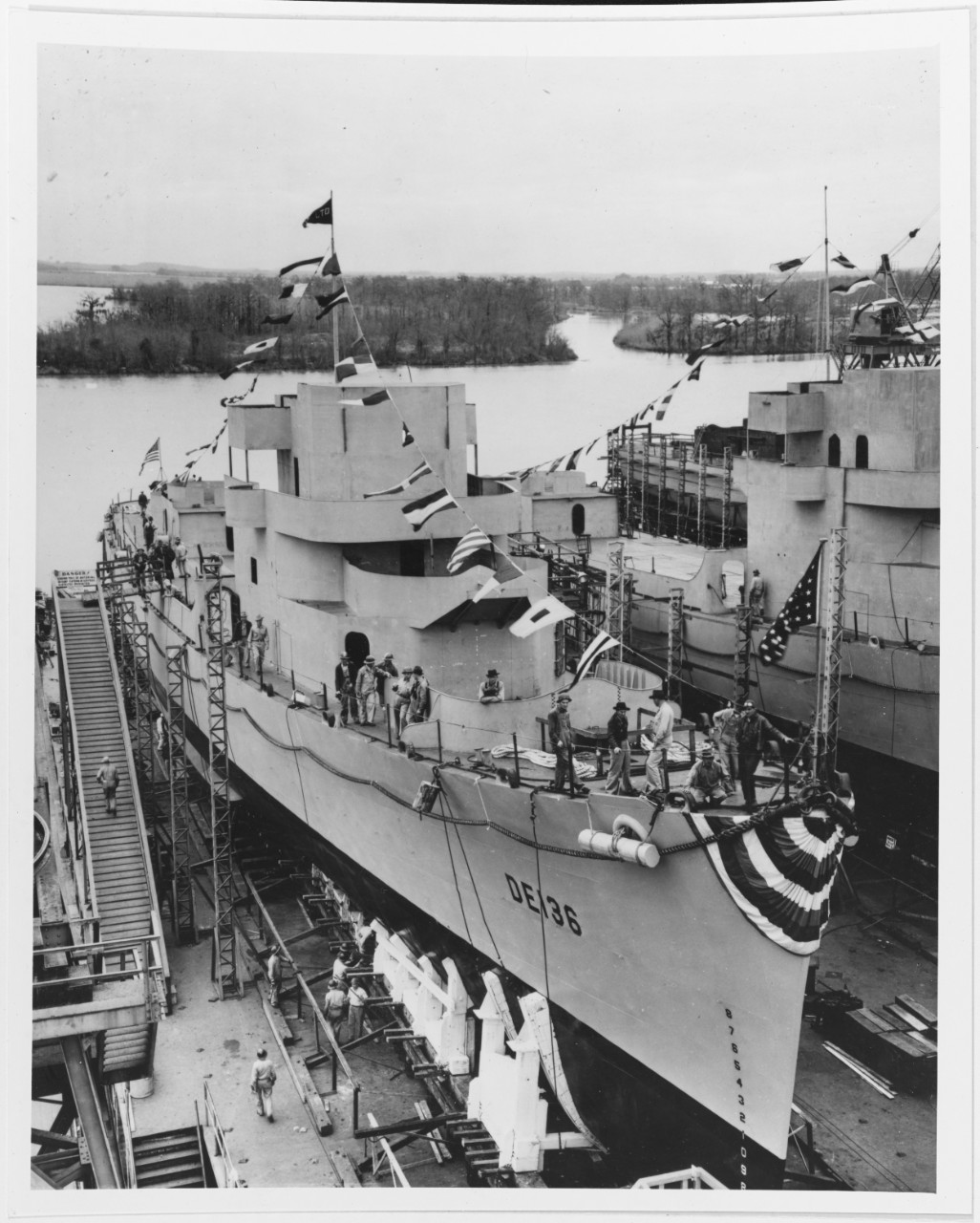
Frederick C. Davis got underway at 0932 on 19 July 1943, steaming down the Sabine River for U.S. Naval Section Base, Sabine Pass, Texas. Upon arrival the next day, the escort ship quickly prepared to get underway, doing so at 1306 on 21 July. At 1551 the next day, Frederick C. Davis stood in to Dock A, Todd Shipbuilding & Dry Dock Co., Galveston, Texas.
At 1356 on 22 July 1943, the escort ship stood out of Galveston Harbor for Naval Station Algiers, La., arriving at 1301 on 27 July. At 1109 on 31 July, Frederick C. Davis weighed anchor and got underway for Bermuda. Entering international waters at 1807, the escort ship maintained a speed of 18.5 knots
Anchored in Chesapeake Bay on 1 October 1943, Frederick C. Davis got underway at 0112 for Naval Station Norfolk, Va., in company with Herbert C. Jones (DE-137). Together, the escort ships operated on escort and anti-submarine duties for the next two months.
In December 1943, Frederick C. Davis composed part of Task Force (TF) 80.2 with Herbert C. Jones. On 1 December, the ships steamed together en route to Algiers, Algeria. Receiving assignments to escort convoys UGS 24 and GUS 23 on 4 December to Oran, Algeria, all ships arrived safely two days later, mooring in Mers El Kebir Harbor. While moored at Oran, Frederick C. Davis underwent temporary repairs to control a leak in the lower sound room. On 11 December 1943, Lt. Cmdr. Oscar W. Goepner was relieved as commanding officer by Lt. Cmdr. Reginald C. Robbins, Jr.
On 12 December 1943, the newly repaired Frederick C. Davis joined Herbert C. Jones in escorting convoys UGS 25 and GUS 24. Upon detachment, the escort ships took up duties escorting a section of convoy UGS 25. At 1045, Frederick C. Davis sighted convoy GUS 24 at a distance of 10 miles. While steaming slightly ahead of GUS 24, an empty lifeboat sighted off the starboard beam only 200 yards from the escort ship raised some concern. Shortly after the discovery of the unmanned lifeboat, both escort ships detached from UGS 25 to join GUS 24.
Four days later, at 1521, a torpedo from U-73 (Kapitänleutnant Horst Deckert, commanding) struck U.S. freighter (Liberty Ship) John S. Copley in convoy GUS 24. The escort ships shifted to concentrate off the port bow of the convoy, with Frederick C. Davis shifting her speed to 18.5 knots. Destroyers Woolsey (DD-437) and Trippe (DD-403) steamed out of Oran to destroy the U-boat, locating her by radar. After both ships depth charged U-73, several exploding underneath the submarine ruptured her bow torpedo tubes, forcing her to surface. At 1930, after the enemy opened up with machine gun fire, Woolsey returned fire sinking U-73 by her stern. Although killing 16 of the submarine crewmembers and suffering three of her own wounded from the exchange of gunfire, the destroyer rescued 34 enemy combatants.
John S. Copley steamed damaged but still seaworthy into Oran on 17 December 1943, escorted by Frederick C. Davis and Herbert C. Jones. The escort ships again made way for Algiers on Christmas Day before steaming back to Oran on 29 December. Assigned as escorts for convoy KMS 36 on 4 January 1944, the ships received a second assignment to a special troop convoy on 11 January while anchored in Goulet Du Lac, Bizerte, Tunisia, destined for Naples, Italy. Despite numerous reports of contacts made en route to Italy, all turned out to be false. KMS 36 arrived safely at the Bay of Naples on 13 January at 0912. She reported to Task Force (TF) 81 in connection with Operation Shingle, the planned invasion of Anzio, Italy (22 January).
On 17 January 1944, Frederick C. Davis got underway for an amphibious landing exercise with Herbert C. Jones and destroyer Mayo (DD-422) off Salerno, Italy (17-18 January). On 17 January, after anchoring in the Bay of Naples (15-16 January), Frederick C. Davis received orders from TF 81 to conduct further amphibious landing operation exercises in the Gulf of Salerno. Getting underway at 0838, she accompanied assault Convoy NAM-1 until receiving new orders at 1047 to overhaul assault convoy NAM-2. Assault convoy NAM-2 included several LSTs (tank landing ship. Frederick C. Davis took up an anti-aircraft and anti-submarine patrol on the left flank of TF 81, engaged in the amphibious landing exercise in the Gulf of Salerno.
At 0705 on 18 January 1944, the escort ship made way for Naples, Italy, entering the port at 0805. Remaining anchored in the Bay of Naples from 19-20 January, Frederick C. Davis got underway at 0522 in company with Force X-ray of TF 81 en route for amphibious landing operations. At 2115, she detached from the assault convoy and proceeded to her assigned screening area “X-ray Able,” on the left flank of the assault force, approximately 12 miles from Red and Blue beaches.
D-Day for the Anzio beachhead, set for 22 January 1944, began with H-hour at 0200. Frederick C. Davis observed gunfire in the direction of the beachhead from 0150-0155. The escort ship, designated as a relief flagship, received orders to take on board Force Command if necessary. Moving into the transport area at 0445, Frederick C. Davis provided anti-submarine and anti-aircraft protection for ships in fire support areas number two and four, remaining in sight of the force flagship. She remained in this capacity for the remainder of the month, patrolling the anchorage area and ship lanes off Capo D’Anzio (23-31 January).
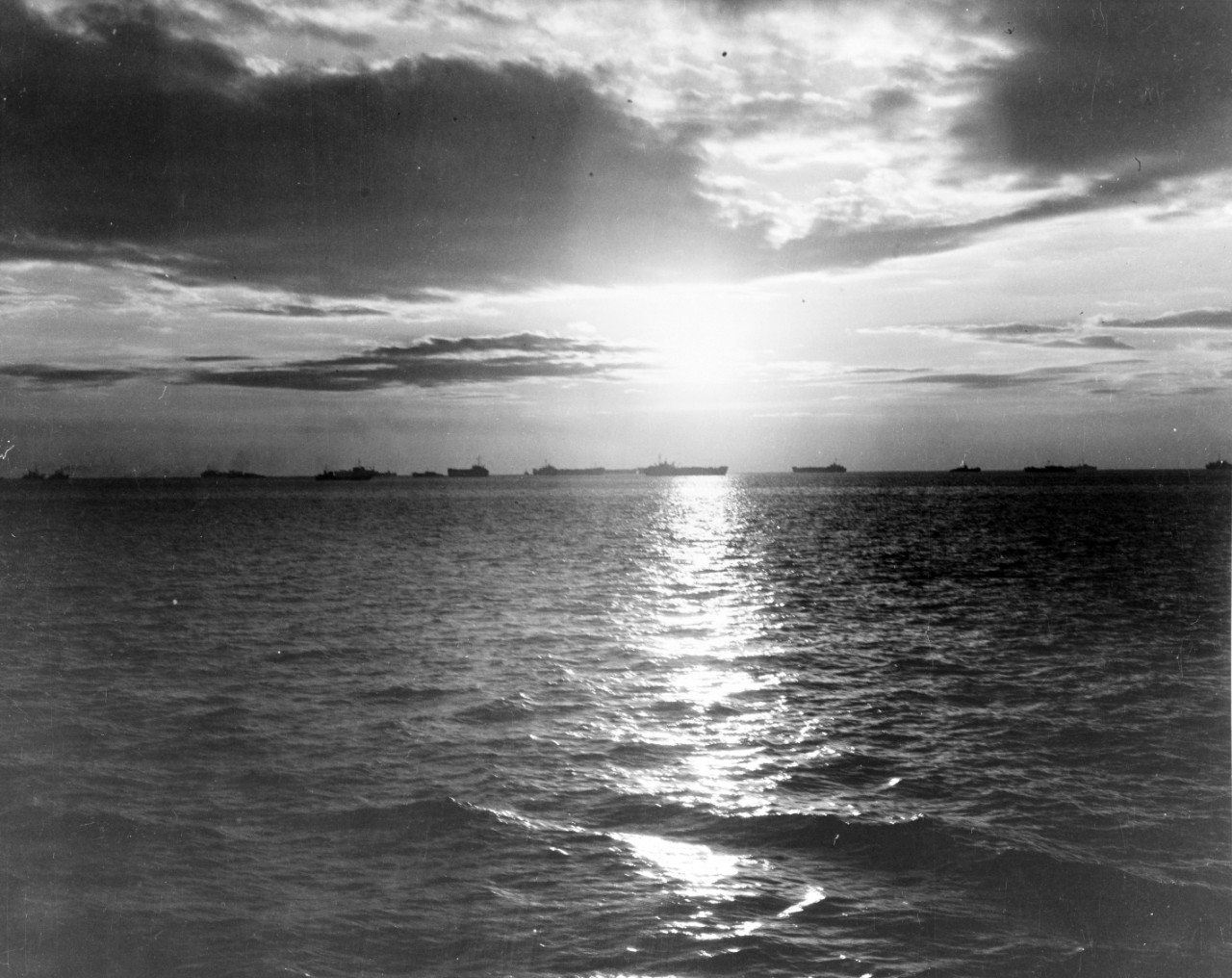
Frederick C. Davis experienced over 100 air raid alerts and 29 actual bombings while off Anzio. Surprise attacks were very few due to the effectiveness of the fighter-director ship, a special U.S. Army “Y” team on board, and excellent combat air patrol (CAP) protection. The escort ship maneuvered as close to Anzio harbor as safe navigation allowed to afford more protection to ships unloading and harbor facilities during the dive-bombing attacks.
In the same span, Frederick C. Davis shot down three enemy aircraft -- two fighter-bombers and one medium bomber of an unknown type. The enemy tactics at night included horizontal and dive-bombing after dropping flares. On 24 January 1944, the escort ship splashed two enemy aircraft after a fighter-bomber group, consisting of four Focke-Wulf FW-190 Würgers, dove out of the sun toward Anzio harbor. Patrolling at two-thirds speed, with battle stations manned, Frederick C. Davis fired on another German aircraft banking to the left on a course parallel to the ship’s at about 1,000 feet altitude. The plane, taken under fire, flew just off the starboard quarter at a range of only 2,000 yards when it caught fire and crashed on the shore.
At 1808, during a concentrated attack by enemy dive-bombers, Frederick C. Davis fired upon a medium bomber. Despite one engine burning fiercely, the pilot maintained speed and altitude. Tracers from all the ship’s guns seemed to strike it as it finally burst into flame and spun out of control, crashing about 800 yards inshore from Cape d’Anzio.
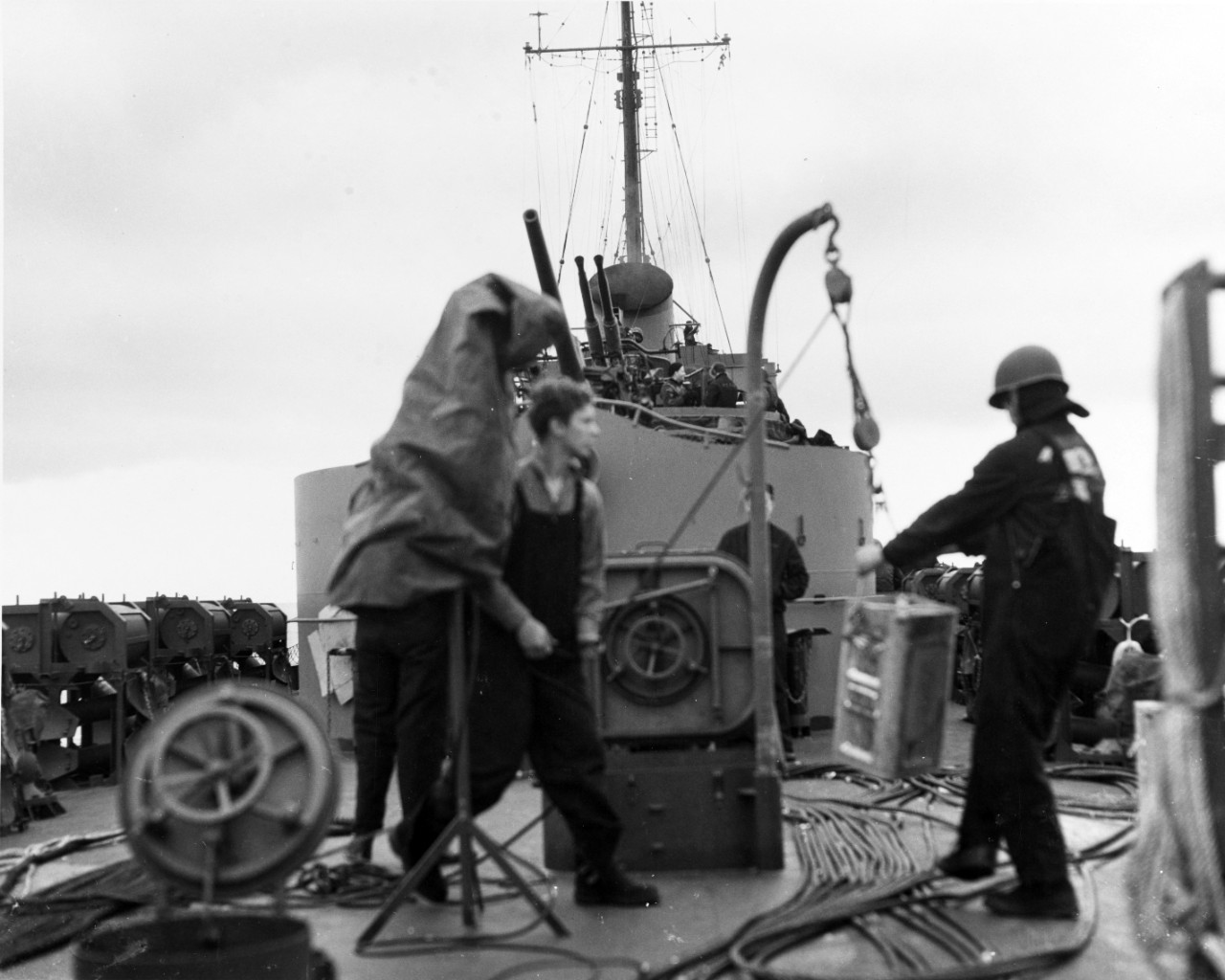
At 1050 on 27 January 1944, radar warned of another enemy fighter-bomber attack. At 1107, the aircraft appeared off the escort ships’ stern, diving toward the harbor. The first group of four unidentified aircraft pressed home their attack. Every ship in the area opened fire until friendly aircraft entered the melee, causing all ships to check their fire.
In the wake of the first attack, a group of two FW-190 Würgers, spotted at 8,000 feet dove into the wake of the first attack group. The 40-millimeter crew on board Frederick C. Davis commenced firing, sending one aircraft into a spin before crashing into the sea about 1,500 yards off her stern. The second fighter aircraft pulled out of its dive at about 6,000 feet, heading for the German lines to the north.
During early February 1944, Frederick C. Davis and Herbert C. Jones received assignments to combat German Henschel Hs 293 anti-ship radio controlled glide bombs with special equipment brought on board for that purpose. During the week of operations off Anzio, the only serious enemy operations against ships in the task force came from aircraft and mines. Shelling by enemy shore batteries remained sporadic, causing minor, if any, damage to the task forces.
Radio-controlled bomb attacks occurred throughout the entire week of the invasion. Frederick C. Davis and Herbert C. Jones acted as jamming ships to combat the Germans’ glide bombs, colloquially known as Fritz X. On 23 January 1944, from 1763-1841, the escort ships jammed six control signals; the next day, from 1743-1819, both ships jammed 17 control signals; the destroyers managed to jam 15 signals on 26 January, from 1743-1801; and finally on 30 January, the escort ships jammed 21 control signals from 1750-1804. Two Royal Navy destroyers, one British cruiser, and one Liberty ship took bomb hits during these attacks. Heavy smoke or darkness allowed little observation of effectiveness of jamming.
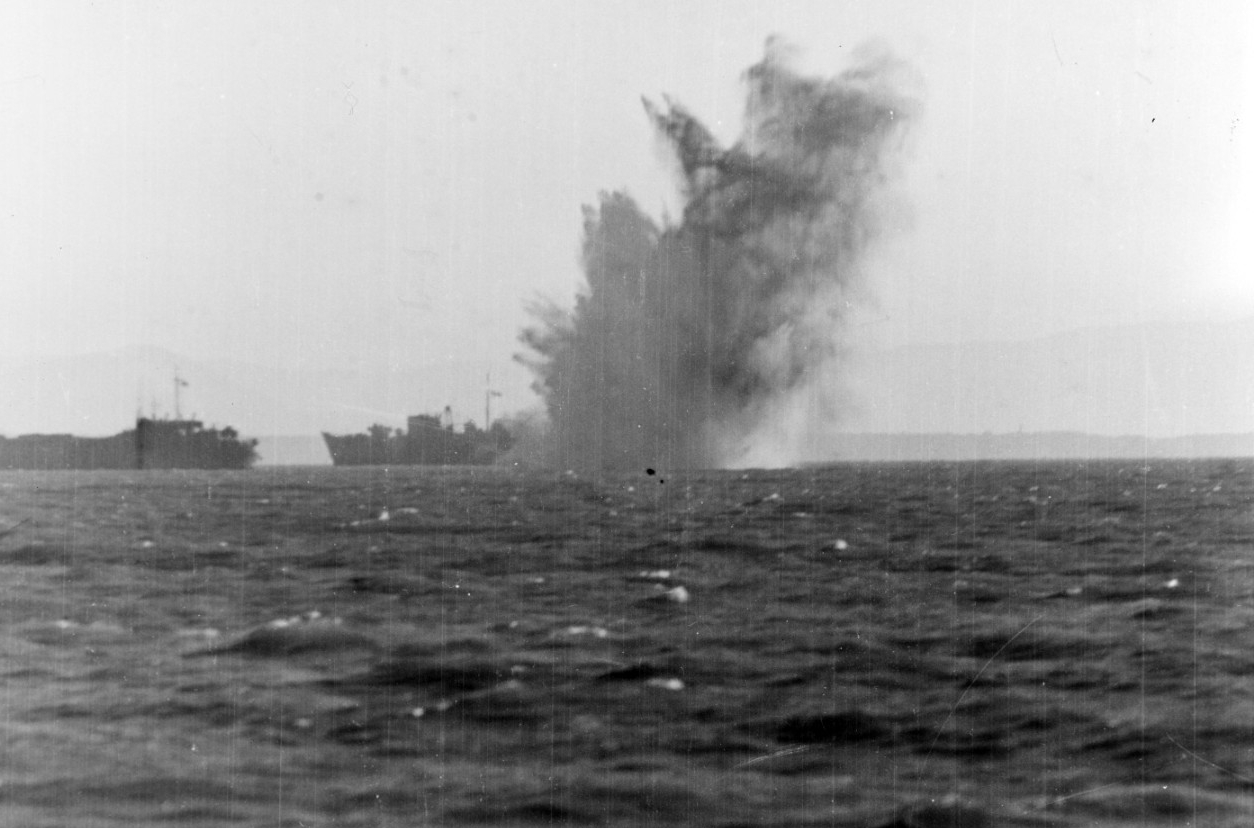
From 1-11 February 1944, Frederick C. Davis maintained anti-aircraft and anti-submarine patrol 1.3-1.5 miles off Cape d’Anzio. Enemy retaliations against shipping continued in the use of fighter-bombers, dive-bombers, use of radio-controlled bombs, aircraft minelayers and shelling by long range artillery (up to 270-millimeters in size). Gunnery doctrine on board the escort ship evolved into firing on any aircraft seen diving or on known hostile aircraft spotted during daylight, and only on visible targets attacking at night. Heavy smoke proved the best night defense against flare-lighted attacks. Few if any air attacks could be termed surprise attacks due to an efficient warning system by Stand-Off Radar (SOR), as well as efficient monitoring of German voice circuits by the U.S. Army “Y” team on board Frederick C. Davis.
At 1630 on 1 February 1944, 15 FW-190 Würger and Messerschmitt ME-109 aircraft sped in from the northwest and turned north of Anzio to dive-bomb and strafe allied ships. Friendly fighters intercepted the German aircraft, downing several. The next day, at 1150, two ME-109s dived with the sun behind them from 2,000 feet, before allied anti-aircraft batteries opened up. The enemy fighters dropped bombs in the harbor, causing no damage. A later attack by a further 15 FW-190s and ME-109s at 1315 also produced no damage.
Due to heavy winds and poor visibility on 4-5 February 1944, enemy air activity remained very slight. However, enemy land batteries opened up, shelling the anchorage area between 0830-0850 on the 5th, causing no known damage to shipping. A light air attack on shipping later in the day also produced no results, as all bombs fell wide of allied ships.
With the weather clearing on 6 February 1944, the Germans managed three strong and two light air attacks. The first commenced at 0325, when approximately 20 twin-engine medium bombers, probably Junkers JU-88s and Dornier Do-217s, approached the Anzio-Nettuno area from the northwest at altitudes between 15,000 to 3,000 feet. Three of the aircraft circled northwest of Anzio, with only two or three over the harbor area. The remainder stayed at an extreme range, pushed out by effective Army heavy anti-aircraft fire. Glider-bomb control signals were received and jammed by Frederick C. Davis from 0324-0408, with one bomb reportedly falling in the Nettuno area to no effect.
The second attack began at 0455, resulting in the escort ships laying heavy smoke to obscure the inner anchorage. Enemy aircraft began making dive-bombing and strafing runs on the smokers. At 0517, one stick of bombs, possibly a 150-pound delayed action type, struck the water 10 yards off Frederick C. Davis’ port bow, rendering the gyro inoperative. No further damage to the escort ships and zero casualties resulted from the attack, although an LCT and LST received slight damage in the harbor.
At 1130, two ME-109s approached from a high altitude, with one splashed by a friendly Supermarine Spitfire. Fourteen unidentified enemy single-engine fighters approached the harbor area at 1145 before turning to dive-bomb and strafe forward areas. Enemy shore batteries again fired on the inner harbor and anchorage throughout the day, inflicting little to no damage to shipping.
On 7 February 1944, Frederick C. Davis held her fire after 15 FW-190s and Me-109s dove out of the sun at 1135 to strafe the harbor area. Several surrounding ships opened fire on the German aircraft, but Frederick C. Davis held her fire due to friendly fighters giving chase. At 1525, 18 enemy bombers, possibly Dornier Do-217s, flew over the port area, diving from 6,000 to 1,000 feet. The Army “Y” team on board passed word to gun control that the enemy planes “were going to bomb” at 1525. Shortly thereafter, with the aircraft visually sighted, Frederick C. Davis opened fire, downing one dive-bomber and damaging another. Despite the fire from the allied ships, bombs landed in an evacuation hospital area, causing numerous casualties. The destroyer expended 20 rounds of 3-inch, 275 rounds of 20-millimeter, and 12 rounds of 40-millimeter ammunition during the attack.
The next day, at 0430 on 8 February 1944, an unknown number of enemy aircraft made a flare-lighted attack on shipping. From 0431-0440, Frederick C. Davis received and jammed radio-controlled bomb signals, with three bombs landing near her but causing no damage. A later check with the Army’s 64th Fighter Wing revealed the dropped bombs belonged to two Dornier Do-217s flying at an altitude of 11,000 feet.
Two more attacks, one at 0740 and the second at 1150, caused no damage. Despite expending nearly 400 rounds of ammunition, Frederick C. Davis managed not to hit any of the 12-14 enemy fighter-bombers in the group. After the second attack, the weather became unfavorable for further sorties, although German land-based artillery continued firing into the harbor installations.
With improved weather conditions on 9 February 1944, the enemy commenced a series of heavy attacks at 1630, when five fighter-bombers dropped bombs in the port area. Gunners on board often had trouble firing on these aircraft, as the enemy often passed out of range as quickly as they flew over the task force. Frederick C. Davis’ gunners expended just 10 rounds for her 3-inch guns and 165 rounds of 40-millimeter ammunition during the attack. The night passed with several more alerts, but the Germans concentrated most of their focus on forward areas and not the allied ships.
Bright moonlight continued to favor the German pilots throughout the early morning hours of 10 February 1944. At 0406, lookouts and radar picked up a strong German submarine sighting, approximately 10 miles from Frederick C. Davis. The U-boat’s position, in an area where torpedoes damaged three LSTs earlier, brought ships from Task Group 81.6 in for the hunt. With no submarines sighted in the area, Frederick C. Davis battened down as the weather turned once again, anchoring off Capo d’Anzio at 1900. Two days later, on 12 February, the escort ship departed at 1210 for Naples, relieved by Herbert C. Jones. Aside from sighting and reporting a mine to a British minesweeper while underway, she safely entered Naples harbor with no further distractions at 1735.
Steaming to Palermo on 14 February, Frederick C. Davis returned to Naples two days later, before making way to Anzio to relieve Herbert C. Jones. The escort ship resumed anti-aircraft and anti-submarine patrols in the inner anchorage area. Enemy aircraft, continuously overhead throughout the day, directed repeated attacks against shore installations.
During the first attack at 1320, Frederick C. Davis fired briefly at enemy dive-bombers, expending ten rounds of 3-inch ammunition and twelve rounds of 40-millimeter. None of the German raids caused any damage to shipping. On 18 February, first enemy raid at 0315 also failed to produce any damage to allied vessels. However, the flight was one of the first to commence mining the harbor, although no damage immediately resulted from the German deployment of sea mines.
Six separate enemy air attacks on shipping occurred on 21 February, commencing at 0013, with a flare-lit heavy bomber attack. Shore-based ant-aircraft fire broke up and prevented the German attacks from succeeding. The first of a series of attacks began at 0700, when eight unidentified fighter-bombers raided the anchorage area, flying with the sun at their backs to bomb U.S. ships. A formation of four Junkers JU-88 bombers passed directly over Frederick C. Davis at only 2,000 feet. All allied vessels opened fire on the raiders, disrupting the attack and downing one of the enemy bombers a mile astern of the escort ship. None of the allied warships reported any damage.
On 23 February 1944, an attack by unidentified enemy bombers closed at 0500 with no damage reported. Frederick C. Davis steamed from Anzio, en route to Naples, with U.S. Army generals Lt. Gen. Mark W. Clark, Commander Fifth Army, Maj. Gen. John P. Lucas, Commanding General, VI Corps, and U.S. Army Air Force Brig. Gen. Gordon Saville on board. Gen. Clark had relieved Gen. Lucas of his command only the previous day, for perceived slow actions against the Germans during the Anzio operation. The escort ship arrived at Naples later that morning.
Frederick C. Davis remained at Naples, taking on fuel and provisions (24-28 February 1944). Getting underway on 29 February for Anzio, she relieved Herbert C. Jones and commenced patrol duties in the anchorage area. Commencing at 1955, enemy aircraft continually bombed the vessels in the anchorage until 2254. Amazingly, despite at least 60 bombs falling amongst the targets, none of the ships suffered any damage.
Relieved by Herbert C. Jones on 5 March 1944, Frederick C. Davis proceeded to Naples. After four days of rest, she returned to Anzio on 10 March. On the 11th, she made way to Oran, Algiers, arriving three days later. Underway from Oran on 24 March, she steamed to Palermo, arriving three days later. The escort ship, ordered back to Palermo on 27 March, resumed anti-submarine patrol duties. Despite several bombing raids opening early April, no direct hits occurred. However, Frederick C. Davis suffered several shrapnel holes in her starboard side.
The largest number of enemy aircraft to attempt an attack on allied shipping during daylight hours occurred on 12 April 1944. The attack proved a complete failure, with combined anti-aircraft fire from U.S. Army and Navy gunners literally “covering the sky with an umbrella of shrapnel bursts,” downing nine Dornier Do-217 bombers. Friendly fighters picked up the bombers as they left the area, downing another eight.
Hilary P. Jones (DD-427) relieved Frederick C. Davis as jamming and traffic control ship on 15 April 1944. The escort ship steamed for Naples to refuel and rest. On 20 April, she returned to Anzio to await orders. A week later, Lt. Cmdr. Reginald C. Robbins, Jr., commanding officer of Frederick C. Davis, received the Legion of Merit for “exceptionally meritorious conduct in the performance of outstanding services….as Commanding Officer of a destroyer escort in the Anzio-Nettuno invasion in January 1944.”
In early May 1944, Frederick C. Davis began escorting LST convoys from Naples to Anzio. From 4-10 June, she remained anchored during the daylight hours, and only got underway for patrol duties in the anchorage area after dark.
Frederick C. Davis, relieved of patrol duties on 19 September 1944, steamed en route for Naples before receiving orders to return to Oran in preparation for an ultimate return to the United States. The escort ship entered the New York Navy Yard on 24 October for a 30-day overhaul that extended through the rest of the year.
Returning to the Atlantic in early 1945, the escort ship resumed anti-submarine training and operations. During December 1944 and January 1945, Adm. Jonas H. Ingram, the Commander-in-Chief, Atlantic Fleet, received information suggesting German U-boats might attempt to attack cities along the eastern seaboard of the United States with bombs and rockets, launching them from the decks of their submarines. Operation Teardrop, a bold plan to create a broad hunter-killer group barrier across the expected course of German U-boats, believed armed with V-1 flying bombs and rockets (although later proven false), and moving toward the North American coast, began to formulate in late 1944-early 1945.
On 9 April 1945, a hunter-killer task group formed in order to intercept the U-boats. Designated the main force for Operation Teardrop, the destroyers and escort ships fell under the tactical command of Capt. John R. Ruhsenberger, commanding officer of escort carrier Mission Bay (CVE-59). Composed of Task Groups 22.11, 22.13, 22.14, and 22.5, Ruhsenberger had tremendous success against the enemy U-boats, destroying five of the seven sent to attack North America. Destroyers attacked and sank U-1235 (Kapitänleutnant Franz Barsch) and U-880 (Kapitänleutnant Gerhard Schözau) on 16 April. A third submarine, U-518 (Oberstleutnant Hans-Werner Offermann) was sent to the bottom six days later. Capt. Ruhsenberger’s vessels depth charged and destroyed the final two enemy submarines, U-546 (Kapitänleutnant Paul Just) on 24 April, and U-881 (Kapitänleutnant Dr. Karl-Heinz Frischke) on 5 May.
On the morning of 24 April 1945, Frederick C. Davis caught U-546 in the act of sneaking through the surface barrier approximately 650 miles northwest of the Azores. At 0829, the sonar striker reported a sharp, clear sound contact, at a distance of 2,000 yards. The target was lost almost immediately as it dropped rapidly aft on the starboard side between Frederick C. Davis and escort ship Hayter (DE-212) and got lost in the wake.
At 0835 Lt. (j.g.) John F. McWhorter, the Officer of the Deck (OOD), regained sound contact from Sonar. The last report, at 0839, gave the target at a range of only 650 yards distant. Lt. (j.g.) McWhorter ordered right hard rudder, turning the ship about to search for the contact. Suddenly, in a single, disastrous moment, a torpedo hit Frederick C. Davis in her port side. The tremendous explosion in her forward engine spaces resulted from a single acoustic torpedo fired by U-546 at almost point blank range.
Panic and confusion reigned in the first few moments on board Frederick C. Davis, compounded by the fact that a general alarm had not sounded after sonar identified the contact as a submarine. As a result, the men were not at their GQ stations when the torpedo struck. Several in the after end of the ship, which suffered less extensive damage, were able to escape topside while most of those forward and on the bridge did not.
Ens. Philip K. Lundeberg, the escort ship’s damage control officer (DCO), was sleeping aft just over the screws of Frederick C. Davis, when he was jolted awake by a tremendous crashing sound. Recalling his shock, he later believed most men forward, especially on the bridge, died outright after the explosion. Making his way topside, he watched “quite a few men running around, putting over life rafts [and] life nets.”
The ship’s galley below decks was ablaze and its equipment overturned and destroyed. “No trace was seen of Captain Crosby,” and a lieutenant supposedly drowned after jumping from the burned-out bridge and into the sea without a life preserver. Among the dead were the OOD, Lt. (j.g.) McWhorter, spotted lying “dead on Gun 2,” and the skipper, Lt. Cmdr. James R. Crosby, Jr., both of whom were standing on the bridge when the torpedo struck
Damage control measures proved useless as several of the larger engine spaces and forward living and storage compartments flooded within seconds. In addition, most of the fire mains could not produce water, so firefighting capabilities proved inconsequential. Nine minutes after the torpedo hit, Frederick C. Davis buckled and broke in two. She sank six minutes later. Realizing he had to abandon ship, Ens. Lundeberg “stepped into the water” and made his way to one of the floater rafts.
About 100 of the escort ships complement of 192 crewmembers abandoned ship on their own initiative, the large majority of whom slept in the after living compartments at the time the torpedo struck. Despite the attempts of some of the crew to set the depth charges to safe before abandoning ship, at least two went off as Frederick C. Davis sank to the bottom. As the survivors drifted in the sea awaiting rescue, Ens. Lundeberg recalled some men likely died from the concussive shockwaves of the sudden underwater explosions. “I was in the water at the time, and I had a rather severe pain in my stomach, it felt as if my insides were being twisted around.”
Only 77 men survived the ordeal in the water, many of the survivors waiting up to three hours for rescue from escort ships Hayter, Flaherty (DE-135), and escort carrier Bogue (CVE-9). Some ten hours later, Flaherty avenged her sister ship, sinking U-546 with gunfire after a running depth charge pursuit finally forced the German submarine to surface. After Bogue rescued the 33 surviving crewmembers from U-546, officers quickly determined the two groups of survivors be kept away from one another. The loss of 115 Frederick C. Davis sailors, only approximately two weeks before the end of the war in Europe, became a bittersweet footnote regarding the successful efforts of U.S. warships to hunt down U-boats during Operation Teardrop. She was the last U.S. naval vessel lost in the Battle of the Atlantic.
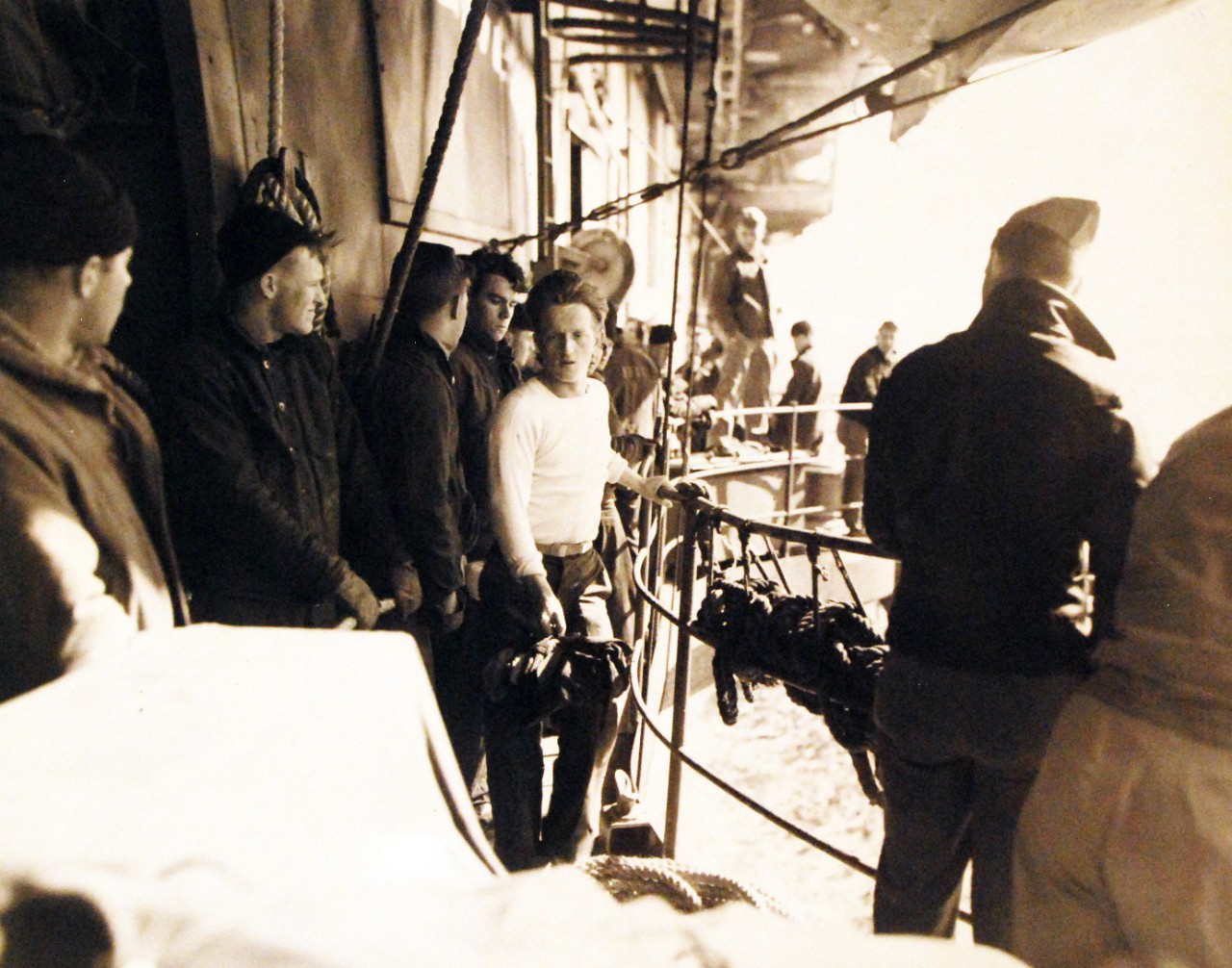
The escort ship received the Navy Unit Commendation (NUC) for her outstanding heroism in support of military operations during the Anzio campaign from 22 January-23 February 1944.
Frederick C. Davis was stricken from the Navy List on 2 June 1945.
Frederick C. Davis earned four battle stars for her service during World War II.
| Commanding Officer | Date Assumed Command |
| Lt. Cmdr. Oscar W. Goepner | 14 July 1943 |
| Lt. Cmdr. Reginald C. Robbins, Jr. | 11 December 1943 |
| Lt. Cmdr. James R. Crosby, Jr. | 30 December 1944 |
Guy J. Nasuti
16 December 2019


